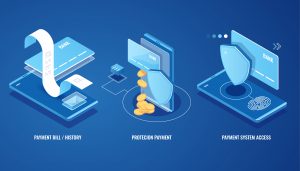These days, payments for products and services purchased online can be issued in a number of ways. And while electronic payments with credit and debit cards prove to be the fastest and most convenient, fraud and information theft can be a major threat. Which is also one of the reasons why some shoppers will avoid using their card to perform a cashless transaction. So in order to make the transaction safer for everyone involved, payment processors have developed what’s called a 3D payment gateway. While it definitely sounds futuristic, these feature has been around for a while and help provide an added layer of payment protection.
One of the reasons why a buyer might dispute an electronic payment is because of fraud. Card-not-present transactions make it possible for unscrupulous users to take information from someone else’s card to make an electronic payment online. As long as you know the numbers on the card, you can pretty much use their money to pay for whatever you want, as long as there are enough funds in the account the card represents. Information theft is another reason why buyers might shy away from issuing an electronic payment online. Punching in such sensitive information as card details raises the possibility of having that important data stolen and used to pay for unauthorized transactions. And that’s precisely what a 3D payment gateway is supposed to protect buyers from. Here’s how it provides extra security for online payments:
Facilities that use a 3D payment gateway significantly reduce the chances of fraud with this OTP feature. It effectively stops individuals hoping to steal card information to make transactions online unless they were also able to get a hold of the account owner’s mobile phone — which is especially unlikely.In some cases, buyers may have to register a unique password with the issuing bank in order to enjoy the benefits of a 3D payment gateway. This unique password or pin will be required to authenticate transactions in place of an OTP.

The term 2D comes from the fact that the gateway protects two domains, namely the customer and the merchant. With a 3D or three domain secure payment gateway, the layer of protection is imposed on the merchant, the issuer, and the interoperability of the payment environment system. Unlike a 3D payment gateway, 2D payment gateways do not require a one-time password or a unique identification code. This means that customers can proceed with their payment with just card information only, increasing the risk of information misuse and identity theft. In essence, the 2D payment gateway is much less secure since it doesn’t use the strong authentication feature involving a unique OTP or code. So if their information is somehow acquired by someone else, the individual can pay for products and services online without having to key in the unique code. This leaves cardholders at risk of fraud, and banks and acquirers at risk of chargebacks.
Keep in mind though that there are scams that aim to override the 3D payment gateway by sending falsified messages or emails under the guise of the individual’s bank asking for their OTP. These phishing scams come from individuals hoping to complete transactions using the card information and the unique code sent to the buyer’s number. That’s why banks will often warn their clients against these scams. No bank or financial institution will ask for your one-time password or your unique code via email or text. In fact, banks will never ask for either of these codes in any situation since they have no purpose aside from authenticating online transactions.
Although the 3D payment gateway provides serious advantages for the buyer, it also works to protect merchant acquiring banks and even the card issuer. Here are some of the most prominent benefits of leveraging a 3D payment gateway for online payments:
The 3D payment gateway offers benefits for buyers, merchants, banks, and card issuers, paving the way for a healthy payment ecosystem where everyone can thrive with a reduced fear of fraud.

While the security it offers is definitely unprecedented, a 3D payment gateway does come with its fair share of downsides. For the most part, these have to do with the buyer’s convenience when executing an electronic payment online:
Keep in mind that the 3D payment gateway is a service that’s exclusive to Visa and Mastercard. Any of the cards issued by these multinational financial corporations are automatically eligible for the 3D protection. However other cards from issuers such as American Express and Discover might not have the added layer of authentication.
No one wants to take on the risk of losing money to fraud and chargebacks during an electronic payment. But because most online businesses and buyers are becoming more open to the possibilities of credit and debit card payments issued online, it’s only fitting that you look into ways to strengthen and bolster the safety features of the process. A 3D payment gateway adds a layer of protection that benefits buyers, merchants, acquirers, and issuers with its advanced authentication process that prevents fraud. With this added feature, you can be sure to keep your funds and information protected if you’re a buyer. For merchants and acquirers, a 3D payment gateway reduces the risk of chargebacks and shift the liability to the issuer instead.